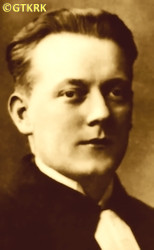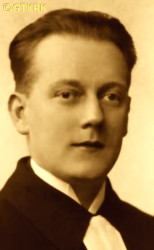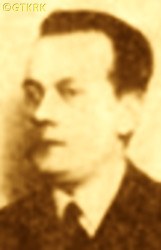Roman Catholic
St Sigismund parish
05-507 Słomczyn
85 Wiślana Str.
Konstancin deanery
Warsaw archdiocese, Poland
full list:
displayClick to display full list

searchClick to search full list by categories
wyświetlKliknij by wyświetlić pełną listę po polsku

szukajKliknij by przeszukać listę wg kategorii po polsku

Martyrology of the clergy — Poland
XX century (1914 – 1989)
personal data
surname
JELEN
forename(s)
George Vladislav Gustav (pl. Jerzy Władysław Gustaw)
function
pastor
creed
Evangelical Reformed Church in Poland PRmore on
en.wikipedia.org
[access: 2023.03.24]
date and place
of death
26.12.1942

KL Dachauconcentration camp
today: Dachau, Upper Bavaria reg., Bavaria state, Germany
more on
en.wikipedia.org
[access: 2016.05.30]
details of death
Volunteer during Polish–Russian war of 1919‐1921.
In 1939 chaplain of the Polish Army reserve.
After German and Russian invasion of Poland in 09.1939 and start of the World War II went to Warsaw hoping to join Polish army there.
It was not to be.
Thus in 10.1939, after the Polish defeat and the start of the German occupation, made his way from Warsaw — then already in the German‐run General Governorate — back to Łódź, which was incorporated into the new German province of Germ. Warthegau (Eng. Province of Wartheland).
Forbidden at the beginning of 1940 to conduct prayers in Polish started to say them in Czech language (Slavonic, as is Polish).
On 14.04.1941 Easter Monday, 14.04.1941 (according to other sources, Good Friday, 11.04.1941) arrested by the Germans in Łódź.
Initially held in EtG Radegast camp.
Next for almost a year held in Sterling Str. prison in Łódź.
For „collection and dissemination of broadcast information and distribution of illegal newspapers” on c. 21.02.1940 sentenced by Volksgerichtshof (People's Tribunal) in Berlin, a German kangaroo court — Łódź was directly incorporated into Germany proper and German law was used — to deportation to a concentration camp — in absentia, the verdict was simply announced to him.
Again moved to EtG Radegast transit camp.
On 10.04.1942 transported to KL Dachau concentration camp where perished in camp's „revir” (i.e. barrack used as „hospital”).
According to the death certificate, prepared in KL Dachau, the „honest” otherwise German „medical doctors” and formalists — and at the same time, unrivaled fairy tale spinners — noted that the cause of death was Germ. „Versagen von Herz und Kreislauf, bei Phlegmone am linken Knie” (Eng. „Heart and circulatory failure, due to phlegmon of the left knee”).
prisoner camp's numbers
29703Click to display source page (KL DachauClick to display the description)
cause of death
extermination: exhaustion and starvation
perpetrators
Germans
sites and events
KL DachauClick to display the description, EtG RadegastClick to display the description, Łódź (Sterling Str.)Click to display the description, Reichsgau WarthelandClick to display the description, Ribbentrop‐MolotovClick to display the description, Polish‐Russian war of 1919‐1921Click to display the description
date and place
of birth
08.07.1900

Warsawtoday: Warsaw city pov., Masovia voiv., Poland
more on
en.wikipedia.org
[access: 2021.10.09]
parents
JELEN Frederick
🞲 ?, ? — 🕆 ?, ?

SEMADENI Angela
🞲 1864, ? — 🕆 1908, ?
presbyter (holy orders)
ordination
21.12.1930

Warsawtoday: Warsaw city pov., Masovia voiv., Poland
more on
en.wikipedia.org
[access: 2021.10.09]
positions held
1936 – 1939
parish priest — Łódźtoday: Łódź city pov., Łódź voiv., Poland
more on
en.wikipedia.org
[access: 2021.07.18] ⋄ PR parish — also: commuting pastor in Zelów and Kuców
EA auxiliary military chaplain — Łódźtoday: Łódź city pov., Łódź voiv., Poland
more on
en.wikipedia.org
[access: 2021.07.18] ⋄ Evangelical–Reformed chaplaincy, Command of the Corps District DOK No. IV Łódź, Polish Armed Forces — prob.; in captain rank
1930 – 1936
minister — Warsawtoday: Warsaw city pov., Masovia voiv., Poland
more on
en.wikipedia.org
[access: 2021.10.09] ⋄ PR parish (16 Leszno Str.) — initially vicar, then deputy parish priest, i.e. adiunk; also: commuting pastor in Żyrardów, prefect of Nicholas Rej's Gymnasium in Warsaw
1925 – 1930
student — Warsawtoday: Warsaw city pov., Masovia voiv., Poland
more on
en.wikipedia.org
[access: 2021.10.09] ⋄ Evangelical Theology Department, University of Warsaw [i.e. University of Warsaw (from 1945) / clandestine University (1939‐1945) / Joseph Piłsudski University (1935‐1939) / University of Warsaw (1915‐1935) / Imperial University of Warsaw (1870‐1915)] — studies were often interrupted due to health reasons
1924 – 1925
student — Paristoday: Paris dep., Île‐de‐France reg., France
more on
en.wikipedia.org
[access: 2020.11.13] ⋄ Faculté de Théologie Protestante (Eng. Protestant Faculty of Theology in Paris)
from 1921
student — Warsawtoday: Warsaw city pov., Masovia voiv., Poland
more on
en.wikipedia.org
[access: 2021.10.09] ⋄ Evangelical Theology Department, University of Warsaw [i.e. University of Warsaw (from 1945) / clandestine University (1939‐1945) / Joseph Piłsudski University (1935‐1939) / University of Warsaw (1915‐1935) / Imperial University of Warsaw (1870‐1915)]
married
others related
in death
POTOCKIClick to display biography John Josaphat, ZAUNARClick to display biography Louis Edward
sites and events
descriptions
KL Dachau: KL Dachau in German Bavaria, set up in 1933, became the main German Germ. Konzentrationslager (Eng. concentration camp) KL for Catholic priests and religious during World War II: On c. 09.11.1940, Reichsführer‐SS Heinrich Himmler, head of the SS, Gestapo and German police, as a result of the Vatican's intervention, decided to transfer all clergymen detained in various concentration camps to KL Dachau camp. The first major transports took place on 08.12.1940. In KL Dachau Germans held approx. 3,000 priests, including 1,800 Poles. The priests were forced to slave labor in the Germ. „Die Plantage” — the largest herb garden in Europe, managed by the genocidal SS, consisting of many greenhouses, laboratory buildings and arable land, where experiments with new natural medicines were conducted — for many hours, without breaks, without protective clothing, no food. They slaved in construction, e.g. of camp's crematorium. In the barracks ruled hunger, freezing cold in the winter and suffocating heat during the summer, especially acute in 1941‐1942. Prisoners suffered from bouts of illnesses, including tuberculosis. Many were victims of murderous „medical experiments” — in 11.1942 c. 20 were given phlegmon injections; in 07.1942 to 05.1944 c. 120 were used by for malaria experiments. More than 750 Polish clerics where murdered by the Germans, some brought to TA Hartheim euthanasia centre set up in Schloss Hartheim in Austria and murdered in gas chambers. At its peak KL Dachau concentration camps’ system had nearly 100 slave labour sub‐camps located throughout southern Germany and Austria. There were c. 32,000 documented deaths at the camp, and thousands perished without a trace. C. 10,000 of the 30,000 inmates were found sick at the time of liberation, on 29.04.1945, by the USA troops… (more on: www.kz-gedenkstaette-dachau.deClick to attempt to display webpage
[access: 2013.08.10], en.wikipedia.orgClick to attempt to display webpage
[access: 2016.05.30])
EtG Radegast: Resettlement camp (as part of German resettlement „program” for Poles in 1939), then co‐functioning with transit‐concentration camp (during genocidal German «Intelligenzaktion» Litzmannstadt in 1939‐1940), finally changed into Germ. Erweitertes Polizeigefängnis (Eng. Expanded Police prison), in Radogoszcz n. Łódź, operational from 1939 till 1945, for Poles from Łódź region. Probably in excess of 40,000 people were held there. For religious this was a transit camp before transfer to KL Dachau concentration camp. (more on: en.wikipedia.orgClick to attempt to display webpage
[access: 2015.09.30])
Łódź (Sterling Str.): Prison for men, founded in 1893, in a tenement houses at 16/18 Sterling Str. in Łódź, by the Russian occupiers (during partitions of Poland). In the interwar period, a Polish state prison. During World War II, a German police prison, used also by the Germ. Geheime Staatspolizei (Eng. Secret State Police), i.e. Gestapo. The prisoners were held in two three‐story buildings with 53 cells and 5 „sick rooms”. Interrogations of arrested Poles, combined with torture, as well as executions ‐ by hanging — were held there. After the German defeat and the beginning of the Russian occupation, the prison of the Commie‐Nazi of State Security Office UB — the unit of Russian genocidal MGB. Executions continued to take place there, this time of Germans and Poles convicted of collaborating with the German occupier, as well as of those convicted of anti‐communist activities and ordinary criminals. Closed in 1964. (more on: pl.wikipedia.orgClick to attempt to display webpage
[access: 2015.09.30])
Reichsgau Wartheland: After the Polish defeat in the 09.1939 campaign, which was the result of the Ribbentrop‐Molotov Pact and constituted the first stage of World War II, and the beginning of German occupation in part of Poland (in the other, eastern part of Poland, the Russian occupation began), the Germans divided the occupied Polish territory into five main regions (and a few smaller). The largest one was transformed into Germ. Generalgouvernement (Eng. General Governorate), intended exclusively for Poles and Jews and constituting part of the so‐called Germ. Großdeutschland (Eng. Greater Germany). Two were added to existing German provinces. From two other separate new provinces were created. Greater Poland region was one of them, incorporated into Germany on 08.10.1939, by decree of the German leader Adolf Hitler (formally came into force on 26.10.1939), and on 24.01.1940 transformed into the Germ. Reichsgau Wartheland (Eng. Wartheland Reich Province), in which the law of the German state was to apply. The main axis of the policy of the new province, the territory of which the Germans recognized as the Germ. „Ursprünglich Deutsche” (Eng. „natively German”), despite the fact that 90% of its inhabitants were Poles, was Germ. „Entpolonisierung” (Eng. „Depolonisation”), i.e. forced Germanization. C. 100,000 Poles were murdered as part of the Germ. „Intelligenzaktion”, i.e. extermination of Polish intelligentsia and ruling classes. C. 630,000 were forcibly resettled to the Germ. Generalgouvernement, and their place taken by the Germans brought from other areas occupied by Germany (e.g. the Baltic countries, Bessarabia, Bukovina, etc.). Poles were forced to sign the German nationality list, the Germ. Deutsche Volksliste DVL. As part of the policy of „Ohne Gott, ohne Religion, ohne Priesters und Sakramenten” (Eng. „No God, no religion, no priest or sacrament”) most Catholic priests were arrested and sent to concentration camps. All schools teaching in Polish, Polish libraries, theaters and museums were closed. Polish landed estates confiscated. To further reduce the number of the Polish population, Poles were sent to forced labor deep inside Germany, and the legal age of marriage for Poles was increased (25 for women, 28 for men). The German state office, Germ. Rasse‐ und Siedlungshauptamt (Eng. Main Office of Race and Settlement) RuSHA, under the majesty of German law, abducted several thousand children who met specific racial criteria from Polish families and subjected them to forced Germanization, handing them over to German families. After the end of hostilities of World War II, the overseer of this province, the Germ. Reichsstatthalter (Eng. Reich Governor) and the Germ. Gauleiter (Eng. district head) of the German National Socialist Party, Arthur Karl Greiser, was executed. (more on: en.wikipedia.orgClick to attempt to display webpage
[access: 2024.06.21])
Ribbentrop‐Molotov: Genocidal Russian‐German alliance pact between Russian leader Joseph Stalin and German leader Adolf Hitler signed on 23.08.1939 in Moscow by respective foreign ministers, Mr. Vyacheslav Molotov for Russia and Joachim von Ribbentrop for Germany. The pact sanctioned and was the direct cause of joint Russian and German invasion of Poland and the outbreak of the World War II in 09.1939. In a political sense, the pact was an attempt to restore the status quo ante before 1914, with one exception, namely the „commercial” exchange of the so‐called „Kingdom of Poland”, which in 1914 was part of the Russian Empire, fore Eastern Galicia (today's western Ukraine), in 1914 belonging to the Austro‐Hungarian Empire. Galicia, including Lviv, was to be taken over by the Russians, the „Kingdom of Poland” — under the name of the General Governorate — Germany. The resultant „war was one of the greatest calamities and dramas of humanity in history, for two atheistic and anti‐Christian ideologies — national and international socialism — rejected God and His fifth Decalogue commandment: Thou shall not kill!” (Abp Stanislav Gądecki, 01.09.2019). The decisions taken — backed up by the betrayal of the formal allies of Poland, France and Germany, which on 12.09.1939, at a joint conference in Abbeville, decided not to provide aid to attacked Poland and not to take military action against Germany (a clear breach of treaty obligations with Poland) — were on 28.09.1939 slightly altered and made more precise when a treaty on „German‐Russian boundaries and friendship” was agreed by the same murderous signatories. One of its findings was establishment of spheres of influence in Central and Eastern Europe and in consequence IV partition of Poland. In one of its secret annexes agreed, that: „the Signatories will not tolerate on its respective territories any Polish propaganda that affects the territory of the other Side. On their respective territories they will suppress all such propaganda and inform each other of the measures taken to accomplish it”. The agreements resulted in a series of meeting between two genocidal organization representing both sides — German Gestapo and Russian NKVD when coordination of efforts to exterminate Polish intelligentsia and Polish leading classes (in Germany called «Intelligenzaktion», in Russia took the form of Katyń massacres) where discussed. Resulted in deaths of hundreds of thousands of Polish intelligentsia, including thousands of priests presented here, and tens of millions of ordinary people,. The results of this Russian‐German pact lasted till 1989 and are still in evidence even today. (more on: en.wikipedia.orgClick to attempt to display webpage
[access: 2015.09.30])
Polish‐Russian war of 1919‐1921: War for independence of Poland and its borders. Poland regained independence in 1918 but had to fight for its borders with former imperial powers, in particular Russia. Russia planned to incite Bolshevik‐like revolutions in the Western Europe and thus invaded Poland. Russian invaders were defeated in 08.1920 in a battle called Warsaw battle („Vistula river miracle”, one of the 10 most important battles in history, according to some historians). Thanks to this victory Poland recaptured part of the lands lost during partitions of Poland in XVIII century, and Europe was saved from the genocidal Communism. (more on: en.wikipedia.orgClick to attempt to display webpage
[access: 2014.12.20])
sources
personal:
pl.wikipedia.orgClick to attempt to display webpage
[access: 2013.10.05], old.luteranie.plClick to attempt to display webpage
[access: 2012.11.23], semper.plClick to attempt to display webpage
[access: 2019.04.16], www.ipgs.usClick to attempt to display webpage
[access: 2012.11.23]
bibliographical:
„Biographical dictionary of Evangelical Reformed clergy. Pastors and deaconesses of Unity of Małopolska and Unity of Warsaw 1815‐1939”, Casimir Bem, 2015
„International Tracing Service (ITS), Bad Arolsen, GermanyClick to display source page”, Arolsen Archives
original images:
reformowani.org.plClick to attempt to display webpage
[access: 2023.03.24], semper.plClick to attempt to display webpage
[access: 2019.04.16], www.jednota.plClick to attempt to display webpage
[access: 2019.04.16], commons.wikimedia.orgClick to attempt to display webpage
[access: 2019.04.16]
LETTER to CUSTODIAN/ADMINISTRATOR
If you have an Email client on your communicator/computer — such as Mozilla Thunderbird, Windows Mail or Microsoft Outlook, described at WikipediaPatrz:
en.wikipedia.org, among others — try the link below, please:
LETTER to CUSTODIAN/ADMINISTRATORClick and try to call your own Email client
If however you do not run such a client or the above link is not active please send an email to the Custodian/Administrator using your account — in your customary email/correspondence engine — at the following address:

giving the following as the subject:
MARTYROLOGY: JELEN George Vladislav Gustav
To return to the biography press below:
 Click to return to biography
Click to return to biography











